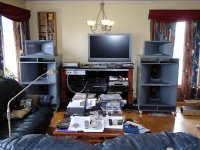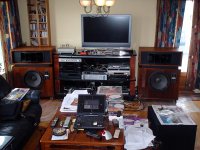The 802 get all the attention. How about using the 802 with the 311?
The 311's are large format.You would need the 21216 adapter to use the 802.IMO you aren't doing the 311's justice with a small format driver on those big horns.They need 288's,299's,etc....
Not OT at all. The 311s are highly prized - you got an obscene deal.
Especially the 311-90's They sell for $1200 a pair or more all day long !
I am in the lower mainland. I have Altec stuff but it can only be listened to when the weather is nice as I have them stored right now.Anyone in lower mainland, BC who wants to compare notes on Altecs? I have some horns and would like to hear what they should sound like
I have 210 cabinets (A4) but not Altec drivers
825 cabinets (A7) but not Altec drivers
811 and 511 horns but not Altec drivers
1803B horns with 288 drivers
1233 speakers (sort of pro version of the Valencia with 421 woofers and 808 tweeters)
604 8H drivers in custom boxes.
A7's can be a bit wieldy for home use, I think the model 19 is one of the better indoor units but the Valencia can hold it's own.From my studies the A7 is not the best Altec hifi speaker for home use, outdoors thats a different ballpark. The Valencia with proper parts is more home friendly.
A modern design with active crossovers should be much better still.
I
I have 210 cabinets (A4) but not Altec drivers
825 cabinets (A7) but not Altec drivers
811 and 511 horns but not Altec drivers
Cal and you are an Altec fan with no Altec Drivers !!
I think the model 19 is one of the better indoor units .
And they are !
Do horns like the 811B produce more distortion than dome tweeters or is that a driver issue?
I have read somewhere...that the horn typically has ~10% of the distortion compared to a dome.
Arne K
A compression driver/horn will generally have less distortion at a given level than a dome tweeter, though at low levels it probably would not be difficult to find examples of dome tweeters with slightly less THD than a compression driver/horn.Can horns do 0.2% or less at under 100dB levels? If not, why would horns be used in hifi?
Horns are generally used in hifi for a desired dispersion pattern, high sensitivity and SPL capability, a 1" dome tweeter will burn up at a far lower level than a real trombone, trumpet , cymbal etc., while a compression driver/horn can reproduce that level using about 1/10th the power.
811-511
Both have their fine points. I rather like the 811 crossed around 1200 Hz... that said the 511 can be crossed down around 750 Hz.
The 511 might not sound quite as good as the 811... but at 750 Hz it's easier to match up with a 16" woofer (mid-woofer).
Given the physical size of the typical woofer used with these things, it's difficult to get a 416 or TAD 1601 close enough to the horn for a 1200 Hz crossover freq.
How low will they go..... call it 50 - 55 Hz..... but in the end you may just not care.
Cyclotronguy
Both have their fine points. I rather like the 811 crossed around 1200 Hz... that said the 511 can be crossed down around 750 Hz.
The 511 might not sound quite as good as the 811... but at 750 Hz it's easier to match up with a 16" woofer (mid-woofer).
Given the physical size of the typical woofer used with these things, it's difficult to get a 416 or TAD 1601 close enough to the horn for a 1200 Hz crossover freq.
How low will they go..... call it 50 - 55 Hz..... but in the end you may just not care.
Cyclotronguy
Look at the graph in post #44, the stock tuning appears to be above 100 Hz, Tom Danley retuned the box around 50 Fb, getting an octave LF extension.Problem is the woofers I can find are 421A not 416's will than have a huge loss in bass?
The higher Fs (and sensitivity) 421A would have more "bass" in the stock A7 box than the 416, to get LF extension with either type of speaker requires a lower Fb.
There certainly is plenty of room in the A7 for large ducts to tune low.
Bear,
Tom may be too modest to tell it like it is, but as one who has employed his Synergy and Paraline concepts in my own cabinets, I can say that they are a significant improvement over the “old school” separate horn approach like the A7, or a horn above a front loaded speaker.
I have been copying design features of various horn cabinets, and doing incremental upgrades on them for decades.
Tom Danley has done the same, and has made many of his own innovations.
Once I was aware of them, I tried and tested his concepts and listened to the results.
My posts in #2 and subsequent posts come because I have heard what those innovations can do sonically, copying a “good old” design when there are design concepts that take up similar space and have far more accurate acoustic response makes no sense to me.
Tom’s concept of coupling mid drivers through an an acoustical LP filter (the small port holes) near the HF driver horn throat entrance could be applied to other expansions, but HF dispersion is largely dependent on the horn wall angle set relative to the wavelength traveled.
In other words, an exponential, hypex or tractrix “Synergy “ type horn would “beam” the HF, since the initial throat would be a narrow angle compared to the latter expansion.
In a conical expansion the sidewall angle determines the directivity pattern down to a wavelength approximating the mouth area, constant directivity is a very good thing if even coverage is desired over a wide area.
As far as seeing IM/modulation effects on the HF driver's diaphragm, the pressure generated by other drivers going in to the HF driver is so much less compared to the pressure generated by the HF diaphragm that it is not a problem. If it were a problem, any co-ax design would suffer from it, empirically we know that they don’t.
Art
Art, no need for me to doubt your listening experience. Since I have yet to hear a recent example of the Danley designed horns, I can't comment on how they might sound.
The early Unity horns seemed if I remember correctly to have a rather abrupt transition from the outlet of the compression driver to the 4 walled conic section. An invitation for diffraction, and a pressure discontinuity... I have no way to know what the present transition on Tom's newest Synergy horns looks like today.
Also the angle of out from the driver's throat plays a role in what the expansion can look like. That angle is important. Some of the newer drivers with neodymium magnets manage a very short section inside the driver, permitting more rapid expansions outward, getting better HF dispersion. This is more or less independent of the type of expansion, since at the outset almost every horn except for the newest Geddes waveguides and other similar designs look very much like conic sections.
Wrt to the LP "filter" at the output of the mids, due to the entry hole, fine, but this is not the issue. It may well be that Tom has worked this into his design and has eliminated the problem, but the air between the entry holes of the mids and the throat of the compression driver is certainly pressurized at mid frequencies! Unless there is a HP acoustic filter at the input to the compression driver the full pressure of the mids would appear to be present on the diaphragm of the compression driver. And this (if this happens) would cause IM in the compression driver.
Anyhow this is a thread on the A7 not the Danley horns...
_-_-bear
It had been my intention to write an “upgrade” article back then; I took pictures and had made some notes on what I did. It involved several minor cabinet modifications (and moving the horn slightly, easy), new drivers (I used a 2226 and BMS4550) and a new crossover.
If there is interest in such a thing, I will find the old hard drive this stuff is on.
I think this would be interesting indeed.
Driver response is often shown in a large sealed box or an infinite baffle.Why do 15" professional drivers like the 421 have a steep dropoff around 150Hz even though its rated down to 40Hz?
Those responses typically roll off at about 12 dB per octave from some upper point.
When the same speaker is placed in a bass reflex box of the correct size, it will have a generally flat response down to Fb, then will roll off at 24 dB per octave.
Different alignments, that is different box size and tunings, will result in different response curves.
One can choose extension in favor of sensitivity, or more boom with less bottom.
- Status
- This old topic is closed. If you want to reopen this topic, contact a moderator using the "Report Post" button.
- Home
- Loudspeakers
- Multi-Way
- Altec Lansing VOTT Clones?

